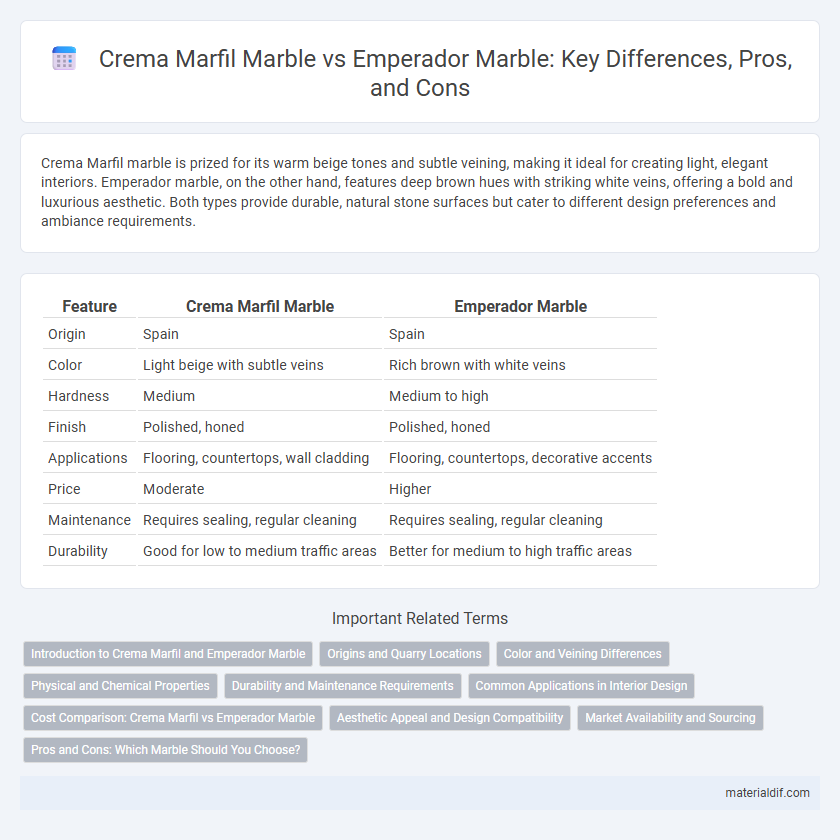Crema Marfil marble is prized for its warm beige tones and subtle veining, making it ideal for creating light, elegant interiors. Emperador marble, on the other hand, features deep brown hues with striking white veins, offering a bold and luxurious aesthetic. Both types provide durable, natural stone surfaces but cater to different design preferences and ambiance requirements.
Table of Comparison
| Feature | Crema Marfil Marble | Emperador Marble |
|---|---|---|
| Origin | Spain | Spain |
| Color | Light beige with subtle veins | Rich brown with white veins |
| Hardness | Medium | Medium to high |
| Finish | Polished, honed | Polished, honed |
| Applications | Flooring, countertops, wall cladding | Flooring, countertops, decorative accents |
| Price | Moderate | Higher |
| Maintenance | Requires sealing, regular cleaning | Requires sealing, regular cleaning |
| Durability | Good for low to medium traffic areas | Better for medium to high traffic areas |
Introduction to Crema Marfil and Emperador Marble
Crema Marfil marble, renowned for its creamy beige tones and subtle veining, originates mainly from Spain and is prized for its elegance in flooring and wall cladding. Emperador marble, distinguished by its rich brown color and dense white or light beige veining, is also sourced from Spain and widely used in luxurious interior designs. Both types offer unique aesthetic qualities and durability, making them popular choices in high-end architectural projects.
Origins and Quarry Locations
Crema Marfil marble is primarily quarried in the Alicante region of Spain, renowned for its warm beige tones and subtle veining that reflect Mediterranean geological formations. Emperador marble, also originating from Spain, especially the Murcia and Almeria provinces, features deeper brown hues with intricate white veining, distinguishing its unique quarry characteristics. Both marbles' origins influence their distinct aesthetic appeal and availability in international markets.
Color and Veining Differences
Crema Marfil marble is characterized by its warm beige to light cream color with subtle, fine veining that provides a soft, elegant appearance. Emperador marble features a rich brown base with striking white and light beige veins, creating a bold and dramatic contrast. The distinct color palettes and veining patterns make Crema Marfil suitable for serene, classic designs, while Emperador suits luxurious and impactful interiors.
Physical and Chemical Properties
Crema Marfil marble features a light beige background with fine veining and a Mohs hardness of around 3, making it moderately soft and suitable for interior applications; its calcium carbonate composition results in high porosity and susceptibility to acid etching. Emperador marble, characterized by deep brown tones with white or light veining, has similar calcium carbonate content but often exhibits slightly higher density and lower porosity, enhancing its resistance to staining and abrasion. Both marbles react to hydrochloric acid by effervescing due to calcite content, yet Emperador's denser structure provides marginally better durability under chemical exposure.
Durability and Maintenance Requirements
Crema Marfil marble offers moderate durability with less visible veining, making it easier to maintain and clean, ideal for low-traffic areas. Emperador marble, known for its rich brown tones and pronounced veining, provides higher durability and resistance to scratches but requires more frequent sealing to prevent staining. Both types benefit from regular maintenance, but Emperador demands more care to preserve its polished appearance in high-traffic or moisture-prone environments.
Common Applications in Interior Design
Crema Marfil marble is widely used for flooring, wall cladding, and bathroom vanities due to its light beige tones that create a warm and elegant ambiance in living rooms and kitchens. Emperador marble, characterized by its rich brown hues and bold veining, is popular for fireplace surrounds, countertops, and accent walls, adding a luxurious and dramatic effect to interior spaces. Both types are favored in upscale residential and commercial projects for their durability and timeless aesthetic appeal.
Cost Comparison: Crema Marfil vs Emperador Marble
Crema Marfil marble generally costs less than Emperador marble due to its more abundant availability and lighter coloration that requires less processing. Emperador marble, prized for its rich brown tones and distinctive veining, typically commands a higher price reflecting its luxury status and limited supply. When comparing cost, Crema Marfil is a budget-friendly choice for elegant interiors, while Emperador marble suits premium projects with a higher investment.
Aesthetic Appeal and Design Compatibility
Crema Marfil marble features a warm beige tone with subtle veining, providing a classic and elegant aesthetic that complements traditional and Mediterranean design styles. Emperador marble is characterized by its rich deep brown color and pronounced white veins, offering a bold and dramatic look suitable for contemporary and luxurious interiors. Both types enhance spaces differently: Crema Marfil fosters a light, airy ambiance, while Emperador adds depth and sophistication, influencing overall design harmony and visual impact.
Market Availability and Sourcing
Crema Marfil marble, widely sourced from quarries in Spain, boasts consistent market availability due to its extensive extraction and global distribution channels. Emperador marble, primarily mined in Europe, especially Spain, tends to have more limited availability as it is extracted in stricter quantities to preserve its rich, dark tones and unique veining. Both types are sought after in luxury construction and design, but Crema Marfil generally sees broader accessibility across international markets compared to the more exclusive Emperador marble.
Pros and Cons: Which Marble Should You Choose?
Crema Marfil marble offers a warm, creamy beige tone with subtle veining, making it ideal for classic and elegant interiors, while its softer composition makes it more prone to scratches and stains. Emperador marble features rich brown hues with dramatic white veining, providing a bold, luxurious look but requires diligent sealing and maintenance to prevent etching and discoloration. Choosing between them depends on whether you prioritize Crema Marfil's timeless softness and warmth or Emperador's striking, darker appearance and durability needs.
Crema Marfil Marble vs Emperador Marble Infographic

 materialdif.com
materialdif.com